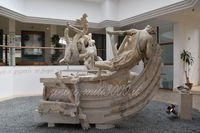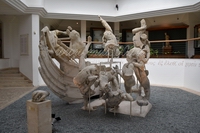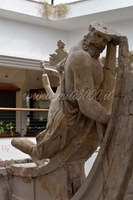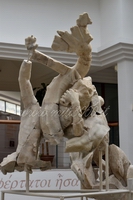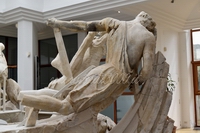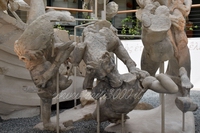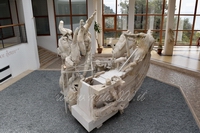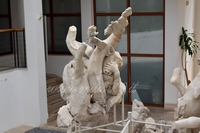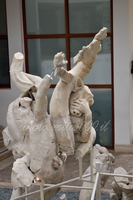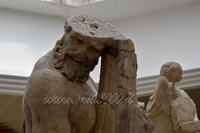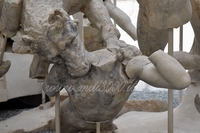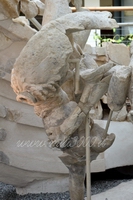Indice dei Musei
presenti in miti3000
Sperlonga Museo Archeologico Nazionale
Testo
Museo Archeologico Nazionale Sperlonga
Sala di Scilla
In questa sala viene esposta la ricostruzione, incompleta perché ancora in corso di restauro, del gruppo monumentale di Scilla, mitico mostro dal busto umano e dal corpo anguiforme, raffigurato nell'atto di afferrare i compagni di Ulisse da una nave sulla quale doveva originariamente essere posto lo stesso eroe.
L'iconografia del mostro è nota da, numerosissime testimonianze archeologiche.
Esso è sempre raffigurato con il corpo robusto di una giovane donna circondato all'altezza dell'inguine da una corona di protomi canine uscenti dalla parte inferiore del corpo e volte ad afferrare sei compagni di Ulisse dalla nave dell'eroe che gli passava vicino. Esso reggeva nella sinistra un timone, mentre con la mano destra afferrava la calotta cranica del nocchiero della nave.
Il gruppo di Scilla, scolpito in un unico blocco di marmo di m 2,50 x m 2,70, è l'opera più grandiosa mai realizzata su questo tema ed il gruppo più complesso creato nella antichità. Dalla composizione di tale gruppo marmoreo si comprende l'orrendo tributo che Ulisse pagò al mostro con il sacrificio di ben sei compagni.
Nulla, purtroppo si è conservato del busto umano del mostro. Probabilmente la testa è da ritenersi perduta, in quanto rinvenuta in passato e poi scomparsa. Anche la mano sinistra con pezzo del timone portata alla luce nel secolo scorso è andata dispersa. I marmi superstiti sono stati ricomposti dallo scultore Vittorio Moriello sotto la direzione scientifica di Baldassare Conticello. Il restauro ha permesso di ricostruire la parte inferiore di Scilla, quella da cui fuoriescono le protomi canine disposte in modo tale che due si trovino all'attaccatura delle gambe, mentre su ciascun lato altre due sono attaccate all'altezza del troncatere. Le due code pisciformi si sviluppano dai glutei attorcigliandosi in fuori.
Della parte inferiore sono conservate due code pisciformi aderenti alla roccia nella base. All'altezza dell'inguine, in circolo, si disponevano le sei protomi canine Di esse, cinque sono in gran parte conservate, della sesta esiste il frammento di una zampa.
Tali protomi afferravano ognuna i compagni di Ulisse, che cadendo dalla nave assumevano varie posizioni dai ritmi complessi e tortili.
La prima protome canina aggettante dal fianco sinistro di Scilla si protende verso l'unico uomo posto sulla nave, il c.d. nocchiero, aggrappato al diritto di poppa, che passava sul fianco destro di Scilla. Il compagno di Ulisse che conserva ancora nel viso tracce di colore originale, è raffigurato in atto di precipitare, mentre la mano destra del mostro gli afferra la parte superiore della testa.
Una seconda protome canina afferra al petto un altro uomo raffigurato con la testa capovolta in atto di precipitare nel mare. Altre due protomi sono in atto di mordere sulle spalle in un contatto mortale altri due compagni dell'eroe, uno raffigurato di prospetto mentre fuoriesce dall'acqua, l'altro sospeso in aria e sostenuto dalla protome.
Gli altri due compagni di Ulisse sono avviluppati nelle spire pisciformi e contemporaneamente attaccati da altre due teste. Una di queste afferra la testa dell'uomo posto nella spira destra, l'altra afferra la gamba destra dell'uomo avvolto nella spira sinistra.
Accanto a Scilla sul lato destro compare la nave marmorea sulla quale è il nocchiero, un uomo barbato di età matura, vicino al quale originariamente doveva essere posto Ulisse. Tale nave trova confronti con il rilievo navale di Agesandros a Lindo (Rodi), e con la Nike di Samotracia, entrambi attribuiti all'arte rodiese e datati agli inizi del II secolo a.C. La nave sembra appartenere al tipo di nave ellenistica detta triemiolia.
Sulla nave, presso il timoniere compare un'iscrizione con i nomi degli autori dell'opera, quegli stessi artisti a cui si deve il Gruppo del Laocoonte dei Musei Vaticani: Athanodoros, Agesandros e Polydoros, autorevoli rappresentanti della scuola rodia.
Gli studiosi concordano sul fatto che tutti e quattro i gruppi sperlongani provengano da una stessa bottega di scultori in cui venne realizzato il gruppo di Scilla. Baldassare Conticello e Bernard Andreae, autori di un fondamentale studio sull'opera, ritengono che Athanodoros, Agesandros e Polydoros abbiano solo copiato in marmo il gruppo di Scilla il cui originale doveva essere in bronzo ed inquadrabile cronologicamente nella prima meta del II secolo a.C.
Da più autori antichi è, infatti, attestata l'esistenza di un gruppo bronzeo raffigurante Scilla, la cui descrizione coincide con quello di Sperlonga. Esso sarebbe stato prelevato da centri ellenistici e portato a Costantinopoli, dove venne innalzato sulla spina dell'ippodromo. Conticello e Andreae ipotizzano che il centro ellenistico dove era collocato il gruppo di bronzo originario di Scilla, fosse Rodi.
Il significato della Scilla di Sperlonga, così come quello degli altri tre gruppi, doveva essere la presentazione dell'eroe Ulisse nel quale l'imperatore vedeva un esempio di autentica virtù virile, un exemplum virtutis.
The Scylla Group.
In this room is exposed the incomplete reconstruction, since it is still under restauration, the monumental group of Scylla mythic monster with human bust and eel body, represented in the act of catching Ulysses companions from a ship over which originally the hero was supposed to be placed.
The Scylla’s group, sculptured in one unique marble block measuring 2,50 x 2,70 metres, is the largest work ever made on this theme and represents the most complex antiquity group ever made. From such marble group composition, it is understandable Ulysses horrible tribute paid to the monster, with the sacrifice of six of his companions.
Regrettably, nothing is preserved from the monster’s human bust. Probably the head is to be considered as lost again. Also the left hand with a part of the ship’s steer, which was brought to light reassembled by sculptor Vittorio Moriello under scientific supervision of Baldassare Conticello. The restauration allowed the reconstruction of Scylla’s lower part, the one where from the dog heads compositions are placed such a way that two of them are to the legs juncture, whilst on each side the other two dog heads are joined at the thigh-bone hight. The two fish tails took development from the glutaeus twisting externally.
From the lower part, are preserved two fish tails adhered to the base of the rock. At the hight of the groin shaped like a crown, the six dog heads were disposed. Of them, five are quite well preserved, of the sixth only one paw fragment exists.
Each of such heads were grabbing Ulysses companions, whilst they were falling out from the ship, they assumed various positions with complex and twisted rhythm.
The first dog head, pushing out from Scylla’s left hip towards the only man, the only placed over the ship, who they called the pilot, clinging to the right hand side of the stern, which was passing on Scylla’s right hip. Ulysses companion which still maintains traces of the original colour over his face, is represented in a falling position, whilst the monster, with his right hand, is grabbing the upper part of the head.
A second dog head grabs at the chest another man represented up side down whilst he is falling into the sea. Other two heads are biting over the shoulders, in a deadly contact, other two hero’s companions, one represented from the front whilst comes out from the water, the other lifted in the air and held by head.
The other two Ulysses companions are wrapped into the fish shaped coils and in the same time attacked by other two heads. One of these heads grabs the head of the man positioned on the right hand coil, the other grabs the man right leg wrapped into the left coil.
Next to Scylla on the right hand side, appears the marble ship over which stands the pilot, a man of a certain age with a beard, close to whom originally Ulysses was supposed to take place. Such ship finds similitude with the naval relief of Hagesandros in Lindo (Rhodes), and with the Nike of Samotracia, both attributed to the Rhodes art dating the beginning of the II century b.c.. The ship appears to belong to the Hellenistic triemiolia type.
Over the ship, next to the steer, appears an inscription with the names of the work authors, the same artists to whom is due the Laocoonte group in the Vatican Museums i.e. Athenodoros, Agesandros an Polydoros, famous representatives of the Rhodes school.
Experts agree on the fact that all four of the Sperlonga Groups, originated from the same sculptors workshop from which the Scylla Group was created. Andreae, Bernard and Conticello, authors of a fundamental study on the work, believe that Athanodoros, Agesandros and Polydoros, have only copied in marble the Scylla Group, of which the original was supposed to be made in bronze and chronogically assigned to the first half of the II century b.c..
From several ancient authors, infact, is attributed the existence of the bronze group representing Scylla, of whom description coincides with the reconstructed Sperlonga group. It would have been taken from Hellenistic centres and brought to Costantinopolis, where it was raised over the hippodrome wall. Conticello and Andreae suppose that the Hellenistic centre where Scylla’s original bronze group was placed, would be Rhodes.
The significance of Sperlonga’s Scylla, as well as that of the other three groups, should have been the presentation of the hero Ulysses, in to which the emperor saw an example of authentic viral virtue, an exemplum virtutis.
Sulla struttura laterale del timone della nave di Ulisse, è incisa la firma degli ideatori del ciclo scultoreo, gli scultori rodii Athanodoros, Agesandros e Polydoros, che Plinio il Vecchio menziona quali autori del Gruppo del Laocoonte (PLIN., Naturalis historia, XXXVI, 37):
“De consilii sententia fecere summi artifices Hagesander et Polydorus et Athenodorus Rhodii”.
L’iscrizione di Sperlonga dice:
Ἀθαν(ό)δωρος / Ἁγησάνδρ(ο)υ καὶ / Ἀγήσανδροσ / Πα(ιω)νίου / κ(α)ὶ /Π(ο)λύδωρος /Πολυ(δ)ώρου / Ῥόδιο(ι) ἐποίησαν
Athanodoros figlio di Agesandros e Agesandros figlio di Paionios e Polydoros figlio di Polydoros, Rodii, fecero.
Foto di Giorgio Manusakis per miti3000

